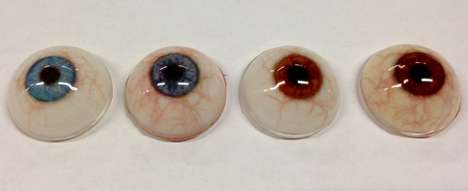November 30, 2013 weblog
British project uses 3D printing for prosthetic eyes

(Phys.org) —A collaboration between UK's Fripp Design and Research and Manchester Metropolitan University has resulted in 3D printed prosthetic eyes/ The eyes are another advancement from Fripp, a product design and research consultancy having gained special attention recently for its work in harnessing digital modeling technologies to create facial prostheses. The eyes now are making news: Fripp is said to be able to make 150 eyes in an hour, and at a fraction of the cost of eyes traditionally made by hand. The time and money difference is especially seen as potentially advantageous for places globally where poor people cannot afford expensive prosthetics of any sort, including prosthetic eyes. Hand-painted eyes take a longer time to produce and cost in the several thousands whereas Fripp Design would be able to turn out prosthetic eyes at less cost.
Tthe waiting time for a conventionally made eye may take a little over two months, whereby the 3D printing system can print eyes and post-process them in a fraction of that waiting time. The ocular prosthesis can be 3D-printed in batches; the intricate color details including iris and blood vessels are not ignored. The eyes are available in small, medium and large sizes. The eye image is digitally created and overlayed into 3D form; the components are printed from powder in color using a machine, and the form is encased in resin.
According to the company, the prosthetic eye project is now in final stages of refinement of the manufacturing process. The company founder, Tom Fripp, talking to the magazine Dezeen, a publication that focuses on architecture, design and interiors projects, said that the technicality in customizing an iris is demanding, and the firm is working on it.
The roots of the initiative date back to December 2010 when Fripp Design and Research and Manchester Metropolitan University entered a collaborative relationship to develop a solution to a global healthcare production problem. India reportedly has expressed strong interest in the 3D printed prosthetic eyes; some people, out of poverty, simply go without eyes that they have lost; coming up with a prosthetic eye that has a low unit cost and high quality may be a key solution; hopefully, eventually, the 3D printed system can deliver a more affordable prosthetic eye.
Although not shipping yet, the prosthesis is noteworthy in that, using knowledge of 3D printing and materials technology, the resulting prosthesis has proven to be feasible.
Earlier this month, meanwhile, The Guardian reported that the company has been working on a range of facial prostheses that are 3D printed. The patient's face is 3D-scanned, specific contours are added to a digital model of the new prosthetic part, for an accurate fit. The parts can be scanned from other people or replicated from the patient's physiognomy.
More information:
www.frippdesign.co.uk/
www.dezeen.com/2013/11/26/3d-p … ted-prosthetic-eyes/
© 2013 Phys.org




















